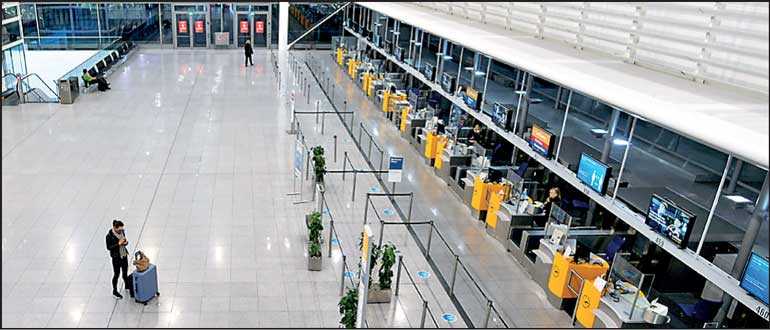Sunday Apr 20, 2025
Sunday Apr 20, 2025
Monday, 16 November 2020 00:00 - - {{hitsCtrl.values.hits}}

Passenger stands in Terminal 2 of an otherwise deserted Franz-Josef-Strauss airport in Munich, Germany - Reuters
The world’s beleaguered travel industry had a glimmer of hope last week. Pharmaceutical giant Pfizer announced a 90% success rate in tests of their vaccine for COVID-19. The company added that it  would continue widespread testing, and hopes to have a usable product within a few months.
would continue widespread testing, and hopes to have a usable product within a few months.
The successful deployment of an effective vaccine would certainly suggest that there is hope for airlines and the entire tourism sector, which has been the biggest victim of the ongoing pandemic. International travel is still at a minute fraction of what it was this time last year, with little hope of it recovering soon. A partial restoration by winter 2021 is now the most optimistic forecast, with full recovery being postponed to 2023 at the earliest.
False optimism
Some sectors of the industry had expectations that a revival would begin by the winter travel season of 2020. That is now seen to be hopelessly optimistic. Even if the Pfizer vaccine and others being developed prove successful, many unanswered questions remain. For how long will a vaccine remain effective? Will there be undesirable side effects? Can it be mass-produced, safely transported and administered at a reasonable cost? The logistics alone of vaccinating the entire world’s population in a short span of time has never been attempted and therefore is bound to be fraught with pitfalls.
Even if and when all these queries are satisfactorily answered, the issue of global competition to gain access to vaccine supplies must still be settled. Many high- and middle-income countries will race to ensure that they get priority access. Where will this leave the poorer nations, such as those in the subcontinent?
The airline world continues to be in turmoil
Meanwhile, with international tourism still almost totally at a standstill, the world’s airlines are in turmoil. Emirates (IATA: EK; ICAO: UAE), one of the three ‘Gulf Super-connectors’, has made further reductions in staff. It is estimated that only fewer than 20 of the 125 Airbus A380s in the airline’s fleet are being used. Many pilots have been terminated, while others are on compulsory unpaid leave for a year.
Etihad Airways (IATA: EY; ICAO: ETD) in neighbouring Abu Dhabi has also announced further job losses and stated that it will transform itself into a ‘mid-size carrier’ in the coming months. Pre-pandemic Etihad had more than 100 aircraft, including ten A380s and 30 narrow-body A320s. It appears that both these types will be discontinued, leaving mainly Boeing 777s and 787s, both wide-body types.
Meanwhile Wizz Air (IATA: W6; ICAO: WZZ), a fast-growing low-cost carrier (LCC) based originally in Budapest, Hungary, has announced a partnership with the government of Abu Dhabi to set up a subsidiary there with the call sign ‘WizzSky’ (IATA: 5W; ICAO: WAZ). Quite possibly Etihad’s fleet of A320s will be absorbed by WAZ. Certainly, Abu Dhabi’s sovereign wealth fund with a balance of $ 875 billion can afford this venture. That it does not seek to prop up EY, which has been losing money since its last profit declaration in 2015, is interesting. It reflects current thinking that most airlines will be forced to completely reinvent themselves if they are to remain competitive in a post-COVID world, and that the LCC model is the one that stands the best chance of succeeding.
Even Qatar Airways (IATA: QR; ICAO: QTR), which continues to maintain a busy schedule with more than 100 destinations while claiming to be the ‘world’s largest international airline’ at this juncture, has announced job cuts and other cost-saving measures. The State of Qatar, with a sovereign wealth fund greater than $ 300 billion and a tiny population (estimated at around 330,000 citizens), could sustain its flag-carrier almost indefinitely, despite QR having never shown a profit.
Interestingly, the government of Norway, with the world’s biggest sovereign wealth fund (estimated at well in excess of a trillion USD) and a population of only 5.3 million, has declined to extend further support to Norwegian Airlines (IATA: DY; ICAO: NAX). Whether the company will survive the winter is hard to say, but Wizz Air has entered the market with a number of flights between cities in the region, adding to DY’s woes.
The dilemma facing state airlines
Asia’s struggling national carriers continue to stare into the abyss. Almost totally reliant on tourist traffic and perennially loss making, as most of them were pre-COVID, there is little hope of revival. Even mighty Singapore Airlines (IATA: SQ; ICAO: SIA) has made drastic changes and begged its owners for continued support.
Those with options and local laws that allow it, such as Thai International (IATA: TG; ICAO: THA) have already filed for bankruptcy protection. Most Asian flag carriers are hardly flying at all, and only surviving on lease rental reprieves granted by the giant leasing companies that own their aircraft. However, these will eventually expire, and the airlines will be forced to find funding to pay the arrears, or cease operations.
Meanwhile, governments in the region are facing a second wave of the pandemic, or in some cases have never managed to control it all. With no income from tourism or the airports, and mounting medical costs plus the upcoming expense of mass vaccinations, how moribund airlines can expect to be allocated even more government funding, is currently a mystery with an outcome that may prove unpalatable for some.
Discover Kapruka, the leading online shopping platform in Sri Lanka, where you can conveniently send Gifts and Flowers to your loved ones for any event including Valentine ’s Day. Explore a wide range of popular Shopping Categories on Kapruka, including Toys, Groceries, Electronics, Birthday Cakes, Fruits, Chocolates, Flower Bouquets, Clothing, Watches, Lingerie, Gift Sets and Jewellery. Also if you’re interested in selling with Kapruka, Partner Central by Kapruka is the best solution to start with. Moreover, through Kapruka Global Shop, you can also enjoy the convenience of purchasing products from renowned platforms like Amazon and eBay and have them delivered to Sri Lanka.
Discover Kapruka, the leading online shopping platform in Sri Lanka, where you can conveniently send Gifts and Flowers to your loved ones for any event including Valentine ’s Day. Explore a wide range of popular Shopping Categories on Kapruka, including Toys, Groceries, Electronics, Birthday Cakes, Fruits, Chocolates, Flower Bouquets, Clothing, Watches, Lingerie, Gift Sets and Jewellery. Also if you’re interested in selling with Kapruka, Partner Central by Kapruka is the best solution to start with. Moreover, through Kapruka Global Shop, you can also enjoy the convenience of purchasing products from renowned platforms like Amazon and eBay and have them delivered to Sri Lanka.